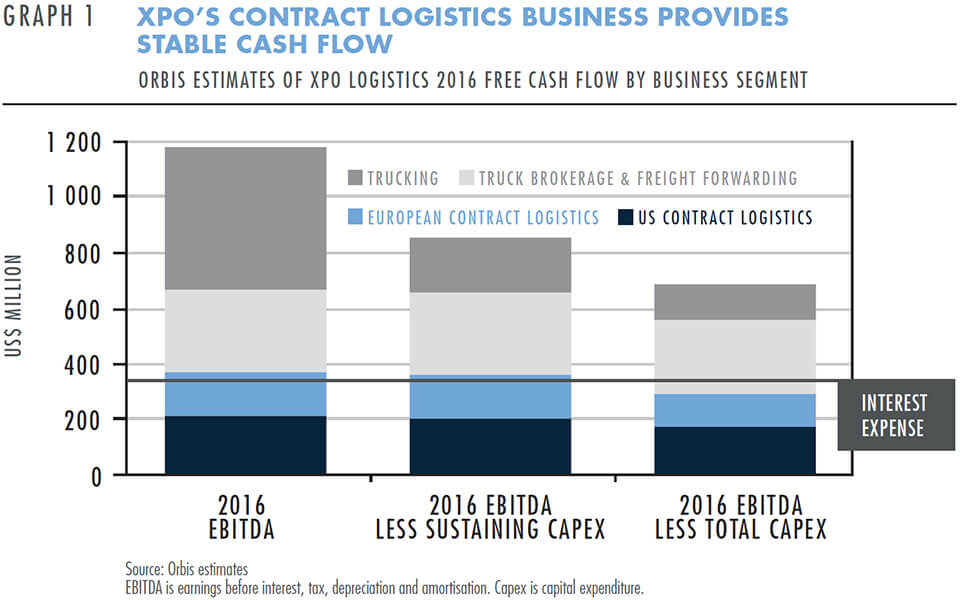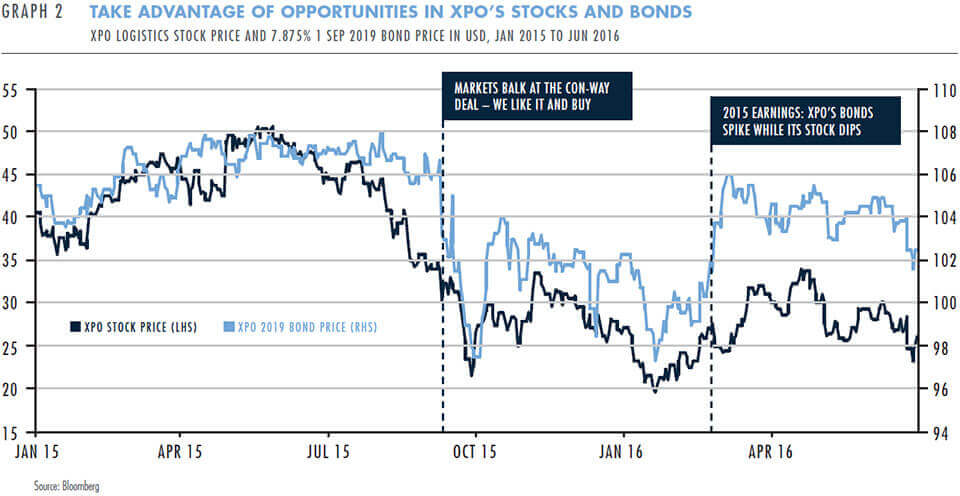Forming contrarian views about the intrinsic value of companies is the core of what we do. In the Orbis Global Balanced Fund, this fundamental company research informs investment decisions for both equities and corporate bonds. Ashley Lynn and Matt Adams, from our offshore partner Orbis, explain how this works, using Orbis’ investments in XPO Logistics as an example.
Across asset classes, Orbis and Allan Gray’s investment philosophy is the same: all securities must compete with each other to be included in our portfolios, and all must do so on a level playing field. In our multi-asset class funds, rather than trying to meet specified bond and equity quotas, we ask what each security will contribute to the risk-reward profile of the portfolio.
XPO is a company we know well and find highly attractive. We hold the company’s equity in our Global Equity Fund, and we hold the equity as well as the 7.875% 2019 and 6.5% 2022 bonds in our Global Balanced Fund. In fact, the Orbis Funds are now the second largest shareholder in the company, after management.
While not a household name, XPO is one of the largest transportation and logistics providers in the world, handling about 150 000 shipments per day in more than 30 countries. The company was built by Brad Jacobs, a highly successful serial entrepreneur who serves as XPO’s chairman and chief executive. Jacobs initially funded XPO with a sizeable US$70 million investment of his own capital in 2011 and has not sold a single share. Today he owns approximately 16% of the company, which has a market capitalisation of US$3.6 billion on a fully diluted basis.
By owning both securities, we retain exposure to the greater potential upside of the equity, but with a potentially less volatile ride and healthy coupon payments
Over the nearly four years since our analysts began following XPO, we have had the opportunity to meet frequently with Jacobs and his senior management team, and have gained confidence in his ability to attract and retain top-notch executives throughout the organisation and its operating businesses. That view has also been independently corroborated through extensive reference checks and in-depth discussions with XPO’s customers and competitors.
Freight logistics companies like XPO are concerned with arranging the collection, transportation, and distribution of real physical stuff. As a result, they can require heavy capital investments — engaging in trucking, for instance, requires an actual fleet of trucks. However, some logistics companies avoid building out this infrastructure themselves, instead arranging contract logistics and providing brokerage with third parties. These ‘asset-light’ businesses can generate attractive returns on capital, and so they are typically seen to merit higher valuations than ‘asset-heavy’ businesses.
Market negativity provides entry point
Up to mid-2015, the market regarded XPO as an asset-light logistics business. Then, in September, XPO announced that it would buy Con-way, a trucking business – complete with a fleet of actual trucks. In response, the market suddenly began valuing XPO as if all of its businesses were asset-heavy and therefore less attractive. We thought that was unjustified, and instead viewed the deal as a positive one that was likely to deliver sizeable synergies and improve XPO’s overall value.
XPO financed the Con-way deal with debt. As the coupon yield on its bonds suggested, the market already believed XPO carried a fair amount of credit risk. On first glance, this makes sense — the company had not generated free cash flow since 2010. So when the company’s debt ratios appeared worse following the Con-way acquisition, markets demanded an even higher yield on money loaned to the company, sending bond prices down. In our view, however, XPO’s cash generation is likely to improve significantly in future years — this is a key component of our estimate of intrinsic value. Given this view, the bonds, as well as the equity, appear to us to be undervalued. Graph 1 shows our estimate of XPO’s cash flow by segment, along with its interest expense.

We believe XPO’s trucking business (which includes Con-way) will make a meaningful contribution to free cash flow, and that the company overall will generate free cash flow well in excess of its interest expense. That cash can be deployed or paid out to the benefit of shareholders, providing equity upside. It can also be used to reduce debt, including by calling bonds at a premium, which could provide even more upside for bondholders.
Cash flow mitigates downside risk
Graph 1 also points to what we view as limited downside for equity holders — and therefore by definition for bondholders too. The trucking business is cyclical, and relying on it alone to meet interest payments could give bondholders some sleepless nights. Yet our analysis suggests that XPO likely won’t need to rely on the cyclical business to meet interest payments at all — the more stable, asset-light contract logistics businesses generate enough cash flow to cover XPO’s interest expense. From this perspective, while the equity offers the possibility of higher upside than the bonds, the bonds have an attractive balance of upside with less risk of loss and a more stable return profile.
The diversification benefit of these different return profiles can be seen in Graph 2.

In its February results call, XPO’s management announced a lower share price target for executive bonuses, and an intention to reduce its debt ratios over time. Equity investors disliked the news, and the shares fell. Bond investors, on the other hand, were apparently cheered by the reduced incentive for management risk-taking, as well as the intention to move towards a stronger balance sheet over time.
A contrarian holding
One benefit of our holistic approach is that we observe the action of the bond and the equity markets simultaneously, drawing information from the times when the two markets appear to be saying different things. By owning both securities, we retain exposure to the greater potential upside of the equity, but with a potentially less volatile ride and healthy coupon payments from the bond as we wait for the market to recognise the value we see.